Samuel Chapman Armstrong of the Hampton Institute writes to Richard Henry Pratt forwarding a letter about girls recruited for Carlisle that are waiting in Yankton until the agent there believes the river has enough water to transport them. Armstrong reports concerns that the recruits will abandon the trip.
Recruitment of Students
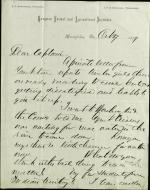
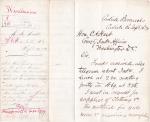
Letter from Richard Henry Pratt informing the Commissioner of Indian Affairs that he has received funds for a recruitment trip out West, and will set off that day. Pratt also requests supplies be sent to the barracks in preparation for his arrival with students, and asks for permission to repair the barracks buildings after the property is…
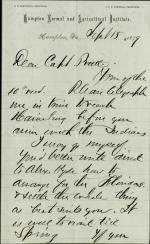
Samuel Chapman Armstrong of the Hampton Institute writes to Richard Henry Pratt discussing arrangements for Indians coming to either Hampton or Carlisle, as well as arrangements to transfer the Florida prisoners north. He also notes that Pratt can turn to the American Missionary Association for funding.
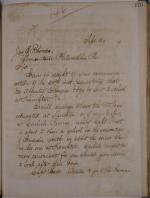
Commissioner of Indian Affairs Ezra A. Hayt's reply to a James E. Rhoades, a man who requested that two Shawnee boys who he is looking after "be sent to school at Hampton, Va." Hayt lets Rhoades know that he can arrange to have the boys be educated at Hampton Institute or Carlisle Indian School. Hayt describes Pratt's plan to go to Indian…
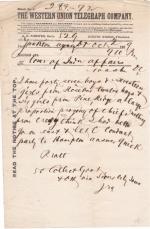
Telegram from Richard Henry Pratt, at the Yankton Agency, to the Commissioner of Indian Affairs informing him that 47 boys and 17 girls from Rosebud as well as 12 boys and 6 girls from Pine Ridge have been recruited. Pratt notes that he will proceed on to Carlisle. The note suggests that Pratt was due to rendezvous with "C" (probably agent…
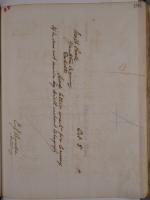
Telegram to Richard Henry Pratt from Commissioner of Indian Affairs E. J. Brooks while Pratt is out recruiting students to attend the Carlisle Indian School that reads, "had better wait for [Charles] Crissey. If he does not arrive by fifth without telegraph". Charles Crissey was the Indian Agent who was recruiting students for the Hampton…
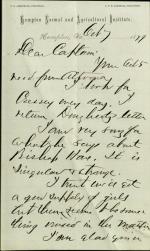
Samuel Chapman Armstrong of the Hampton Institute writes to Richard Henry Pratt, discussing some correspondence from mutual acquaintances. Armstrong also discusses Pratt's recent recruitment efforts, including gender and health concerns.
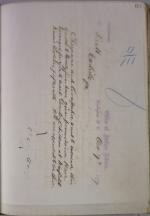
Telegram from Commissioner of Indian Affairs Ezra Hayt to Richard Henry Pratt informing him that Hayt has given permission for an increased recruitment quota from the Cheyenne and Arapaho Agency. The new number of young people will be 25.
Hayt also tells Pratt that the party of young people from Indian Territory will be meeting him…
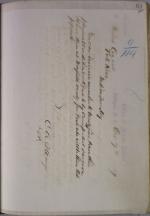
Telegram from Commissioner of Indian Affairs Ezra Hayt to the Agent of Cheyenne and Arapaho Agency John D. Miles which tells Miles that he has permission to recruit 25 young people to be sent to Carlisle.
Hayt orders Miles to have a physician certify these young people's health then send them to Winfield, Kansas to meet Pratt on…
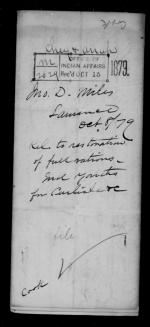
John D. Miles, Agent for the Cheyenne and Arapaho Agency, writes to Commissioner of Indian Affairs Ezra Hayt describing efforts to support the recruitment of young people for the Carlisle Indian School. He also refers to the situation having been "somewhat unsettled" recently due to a proposed reduction in rations. Transcript included. …
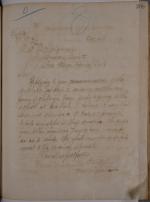
Commissioner of Indian Affairs Ezra A. Hayt informs Indian Agent V. T. McGillycuddy that there is no need to send more young people from the Pine Ridge Agency to the Carlisle Indian School. Hayt states that the quota from other agencies has been increased to meet the original estimate of students.
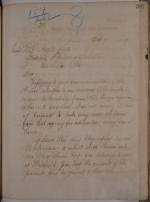
Commissioner of Indian Affairs Ezra A. Hayt's letter to Richard Henry Pratt communicating that it is unnecessary to recruit more children from the Pine Ridge Agency to attend the Carlisle Indian School. Hayt says that he does not think it best to take more young people from their home at present time. Hayt also lets Pratt know that he…
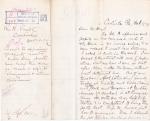
Richard H. Pratt writes to Commissioner of Indian Affairs Ezra Hayt regarding a board to appraise property at the Carlisle Barracks. Pratt notes that, because of the timing of this visit, he will be unable to meet a group of recruited students in the West as planned, and instead suggests sending teachers Alfred J. Standing and Sarah Mather.…
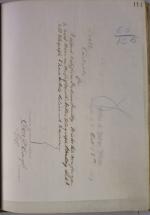
Telegram from the Commissioner of Indian Affairs Ezra Hayt to Richard Henry Pratt which informs Pratt that sixty people are expected to come to Carlisle from Indian Territory.
Hayt asks if Pratt will be able to meet this party on October 15th (in Winfield) or if Alfred J. Standing should be telegraphed instead. He promises that he…
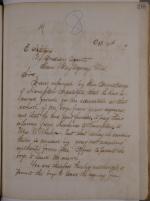
Letter from Commissioner of Indian Affairs Ezra E. Hayt to Indian Agent E. Stephens at Green Bay Agency authorizing him to recruit two Menominee boys from Keshena to go to Hampton Institute, payment for which had already been sent along to Mrs. W. Wheeler from General Armstrong. Hayt also suggests that he might meet up with Indian Agent Charles…
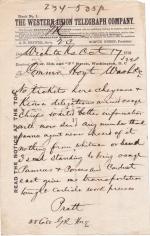
Richard Henry Pratt telegrams the Commissioner of Indian Affairs, noting that no tickets were on deposit for recruited Cheyenne and Kiowa students met in Wichita, Kansas. Pratt also notes that the Osage did not receive enough information about the request for students, and that the Pawnee and Ponca agents had not heard about the request. Pratt…
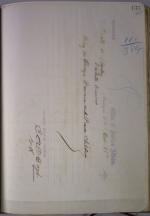
Telegram from Commissioner of Indian Affairs Ezra Hayt sent to Richard Henry Pratt or Alfred J. Standing. (Hayt did not know who was at Wichita, Kansas to receive the telegram.)
The telegram reads: "Bring on Osage, Pawnee, and Ponca children."
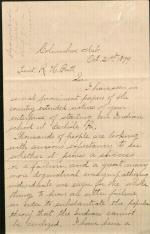
Marianna Burgess writes to Richard Henry Pratt inquiring about a position as teacher at the newly formed Carlisle Indian School. Burgess provides details on her background, and offers to help recruit Pawnee children to attend Carlisle.
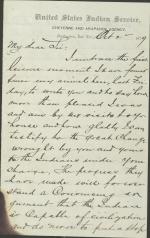
Charles E. Campbell, the acting agent for the Cheyenne and Arapaho Agency, writes to Richard Henry Pratt praising him for his work educating the Fort Marion prisoners of war, and giving him an update on recruitment efforts for Carlisle.
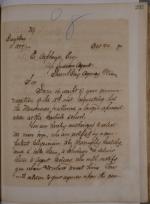
Letter from Commissioner of Indian Affairs Ezra E. Hayt to Indian Agent E. Stephens authorizing the selection of two more Menominee boys to be sent to the Carlisle Indian School. Hayt instructs Stephens to ensure their health is certified by a competent physician and then to rendezvous with Indian Agent Charles Crissey in Chicago.
…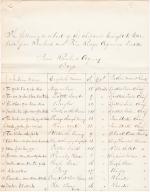
Captain Richard Henry Pratt writes to Ezra H. Hayt, Commissioner of Indian Affairs, regarding the first groups of Sioux, Menominee Ponca, Pawnee, Kiowa, Comanche, Wichita, Seminole, Cheyenne, and Arapaho children and young adults brought to the Carlisle Indian School. Pratt offers a detailed description of the journey, and then lists each…
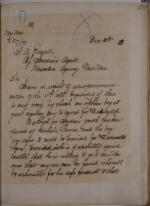
Commissioner of Indian Affairs Ezra A. Hayt's response to a request from Indian Agent S. A. Russell from the Mescalero Agency in New Mexico about if Hayt could help find care for an orphaned boy at his agency. Hayt explains that the Carlisle Indian School had just recently opened and that the boy could attend the school for education provided…
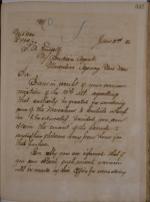
Instructions from Commissioner of Indian Affairs Ezra A. Hayt sent to Indian Agent S. A. Russell at the Mescalaro Agency to pursue gathering "six to ten boys" from the (Apache) Mescalero Tribe to send to the Carlisle Indian School or Hampton, "provided you can obtain the consent of the parents." Hayt instructed Russell to focus on selecting…
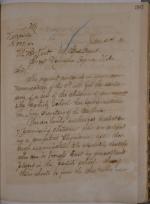
Letter from Commissioner of Indian Affairs Ezra A. Hayt to Indian Agent M. B. Kent at the Great Nemaha Agency that authorized the selection of "6 or 7 promising children" to undergo health screenings and to be brought by Agent Kent to the Carlisle Indian School. Hayt stated that some recruits should be from the Sac & Fox Tribe and the Iowa…
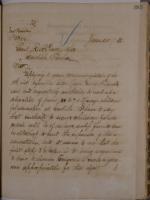
Commissioner of Indian Affairs Ezra A. Hayt's response to Captain Richard Henry Pratt's request to have Reverend A. H. Donaldson send a delegation to procure "50 to 75 Navajo children for education" at the Carlisle Indian School. Hayt encouraged Pratt to first secure funding from Congress before bringing more children to the Carlisle Indian…
